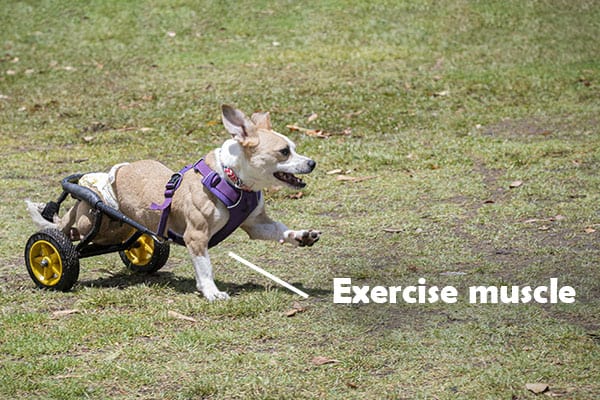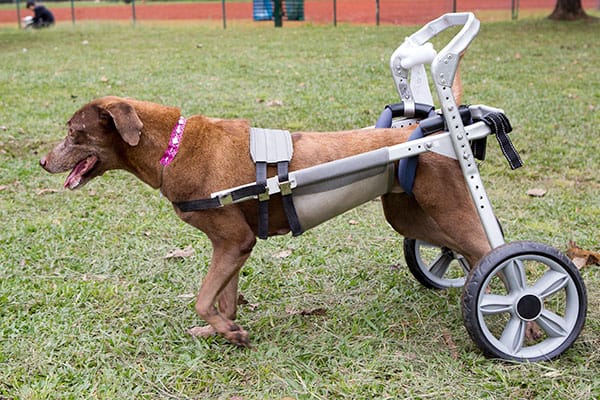On occasion, our posts contain affiliate links. However, we only recommend products that we truly believe in. For more information, visit my privacy policy page.
Phew, this website is a labor of love and largely a one-woman show so unless indicated, all articles written by J.Tsukamoto
Dog wheelchairs have come a long way from the days when only a few lucky pooches and their owner could afford a custom built dog wheelchair designed just for them.
Nowadays, various types of doggy wheelchairs are being mass-marketed bringing down the costs of the wheelchairs and increasing their availability.
While this is great, it's also important to understand the importance of fit and functionality.
An improperly fitted wheelchair can cause more harm than good due to discomfort or the exacerbation of injury / disease.
Read on to learn how to choose the right type of wheelchair for your dog's need and your budget.

Doggy Wheelchairs - Balancing Cost and Quality
Basic, non-customized dog wheelchair models typically cost a few hundred dollars before shipping and handling.
The cost of dog wheelchairs will start getting higher with the more customizations needed.
It’s a good idea to get the best quality you can afford to ensure that your dog has a wheelchair that is functional, comfortable, and easy to maneuver.
Lower priced dog wheelchairs are pumped out in high quantity and are lower quality than customized dog wheelchairs made to order.
Furthermore, buying an incorrectly sized wheelchair can actually cause / exacerabate injury to your dog.
These cheaper dog wheelchairs are typically made in China where the quality of the materials will vary depending on the manufacturer.
Some of the main differences between mass marketed and custom wheelchairs are:
- Weight - Custom dog wheelchairs are usually much lighter
- Wheel Fit / Design - Custom dog wheelchairs have quality wheels made to rotate smoothly
- Fit - Custom dog wheelchairs are made to your dog’s exact measurements therefore will be designed to provide your dog with the most functionality and performance.
- Comfort - Custom dog wheelchairs are usually more comfortable than mass produced dog wheelchairs

The main cons of ordering custom wheelchairs are the price and the time it takes to produce one.
While a mass marketed wheelchair can be bought for around $200, a custom wheelchair can cost between $450 to $1000 and up.
Also custom wheelchairs require correct measurements that may sometimes need to be done by a professional - adding an additional cost.
Choosing between a mass market wheelchair and a custom one boils down to many factors such as your budget, your dog’s need, etc.
While a custom wheelchair is definitely nice - getting your dog a more affordable and correctly sized wheelchair to improve his or her lives is better than no wheelchair at all.

When Should You Consider a Dog Wheelchair?
Dog wheelchairs are a must for dogs whose quality of life is compromised due to mobility issues.
In addition to injured and paralyzed dogs, dog wheelchairs can also benefit elderly dogs who can't go as far as before without losing their balance or tiring.
A doggy wheelchair will allow your dog to get the exercise and recreation they need to be healthy and happy.
In certain sad situations, some dog owners must face the possiblility of compassionate euthanasia due to their dog's severe lack of mobility.
In these cases, if a dog wheelchair can prevent this from being the only choice, then it's defitinely something worth trying.

Can Dog Wheelchairs Rehabilitate Dogs?
For dogs with non-permanent disabilities or injuries, dog wheelchairs can definitely assist in rehabilitating the dog.
All dogs can benefit from the mobility assistance of a dog wheelchair that allows them to exercise their body and increase muscle strength and endurance.
Depending on the type of dog wheelchair, the wheelchair may be modified as mobility improves for the dog.

Can Dog Wheelchairs Cause Harm / Injuries?
Unfortunately, dogs fitted with dog wheelchairs that do not fit or function properly can be susceptible to more harm than good.
Finding a properly fitted wheelchair is of critical importance, especially since dog’s cannot communicate their pain or discomfort.
Purchasing a customized dog wheelchair will cost more but you’ll have the peace of mind knowing that you’re getting a wheelchair that is functional, safe, and well-fitted.
If you simply cannot afford a customized dog wheelchair but still would like to provide your dog with mobility assistance, ask your vet for recommendations and opinions on wheelchairs you may be considering.
Additionally, check in your area for rehab specialists that may be able to help you with measuring and fitting you with an affordable wheelchair option.
If your dog’s need for a wheelchair is temporary, you can also look into renting a dog wheelchair.

How Long Can a Dog Stay in a Wheelchair?
A dog should only be in a wheelchair when being supervised and in need of mobility assistance during walks, playtime, and socialization.
It’s important when first introducing your dog to a wheelchair to keep the time in the wheelchair short, positive, and filled with rewards.
Then you can slowly build on the time spent in a wheelchair until your dog is fully comfortable using it.

Types of Dog Wheelchairs
There are quite a few types of dog wheelchairs to accommodate your dog’s support needs.
The two most common types include the rear support wheelchair and the full support wheelchair.
- Limb injury
- Paralysis
- Amputees
- Ruptured Disc
- Arthritis
- Hip Dysplasia
- IVDD
- Old age
- Balance support
- Neurological Issues
Rear Support Wheelchair
Rear support wheelchairs are made for dogs with hind leg weakness / paralysis. The rear wheelchair can support your hind legs fully or partially if your dog still have some mobility in their hind legs.
Full Support Wheelchair
A full support wheelchair also called four-wheel and quad wheelchair is designed to support dogs with weakened limbs throughout.
To propel the wheelchair, your dog still needs some front leg strength.
Full support wheelchairs are a good choice for dogs suffering from progessive diseases like Intervertebral Disc Disease (IVDD) and Degenerative Myelopathy (DM).

How To Measure Your Dog For a Wheelchair
The most critical step for fitting your dog with a wheelchair is of course, measuring.
Depending on where you get the wheelchair from, manufacturers will require different types of measurements.
The following are the most common.
First get your dog’s weight to determine the approximate base size of the wheelchair
Measure Front Leg
With your dog in a standing position, squarely beneath the shoulders, measure from the bottom of the paws to the top of the shoulder blades .
Measure Rear Leg Height
If your dog can stand, measure from the dog’s pelvic floor bone to the ground for “for to groin measurement. You can place your hand between your dog’s legs for support and to ensure that the hind legs are at their highest natural position.
Alternatively, you can measure your dog’s rear leg height with your dog lying down
Have your dog lie down comfortably to one side. With a tape measure start from the fold of flank (FOF) or very top of your dog's thigh (at the crease) and then measure down to your dog’s toe pads. Do not pull or stretch our dog’s legs while measuring.
Additional Measurements That May Be Necessary
Torso to Abdomen Length
With your dog either standing or lying measure from the center of their front legs to the beginning of their rear legs.
Thigh Width
Measure your dog’s larger thigh from the inside of the rear leg across the thigh to measure the width of your dog’s thigh.
Measurements Requiring a Caliper
If you’ll be opting for a custom wheelchair, you’ll need a caliper to properly measure your dog’s width.
You can easily make a homemade caliper using cardboard.
Once the caliper is made, you’ll want to take measurement from three separate areas including the
- Shoulder
- Ribs
- Rump
For Rear Leg Amputees
If you dog is a rear limb amputee, you’ll need to take a measurement of their remaining leg from the medial to lateral portion. This measures the thickness of the thigh.

For Front Wheel and Quad Carts
Front Leg Front Chest Width
Start the measurement from the inside of both legs to determine how far apart the space is between them.
Chest to Shoulder Center
Using a straight measuring tool measure from the center of your dog’s shoulder to the front of the chest. Do not bend or wrap the tape measure.
Rib Cage to Floor
Measure the lowest part of your dog’s rib cage down to the floor.
Center Shoulder to Center Thigh
Measure from the center of your dog’s shoulder to the center of your dog’s thigh.
Floor to Top of Back (Thigh)
Measure from the floor to the top of your dog’s back at the thigh point.

Doggy Wheelchair Features To Consider
Adjustability - When opting for a non custom wheelchair, it’s best to choose a wheelchair that can be easily adjusted to adapt to your dog’s size and needs. Additionally, adjustable wheelchairs has the ability to benefit multiple dogs
Wheels:
Foam Wheels - The most common and durable type of wheel. Puncture-proof and adaptable to various terrain.
Air-Filled Tires - For the dog on the go! These types of wheel provide more suspension and can handle various types of rough terrain.
Weight - Lighter wheelchairs make it easier for the dog to move around and maneuver. It’ll also be easier for you to transport as well.
Build Quality - In addition to being light, a dog wheelchair should be constructed to be strong and rigid. Dog wheelchairs made out of aircraft grade aluminum are both strong and lightweight.
Comfort - Choosing a comfortable dog wheelchair is essential, especially for older dogs. Dog wheelchairs have various types of comfort sleeves, etc. The padding for the dog wheelchair should provide ample support while being comfortable to rest in.
Veterinarian Approved - Choosing a wheelchair that has been approved by veterinarians is essential to ensure that your dog has a functional and safe wheelchair

Final Thoughts
Hopefully this article has informed you about the range of options available in the world of doggy wheelchairs.
Just remember that fit, comfort, and functionality are the three key aspects to prioritize when choosing a wheelchair.
Although the costs can be high for dogs with extra modifications needed, the benefits from providing your beloved pooch a properly-fitted wheelchair are more than worth it.
After all since our dogs would want the best for us, we should do the same for them.

Thanks for visiting Myfirstshiba.com! We do our very best in providing our readers with awesome content about our beloved Shiba Inu breed. Some of our articles include reviews and recommendations to our favorite products. We do occasionally earn commissions from certain affiliate links that help support our work and mission. Thanks again for visiting. Shiba Kisses To All!

